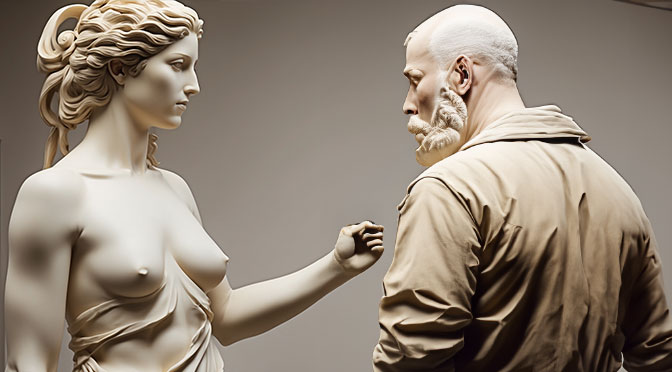Greek mythology is a vast collection of stories and legends that have inspired countless artists throughout history. One such tale is that of Pygmalion and Galatea, the sculptor who fell in love with his own creation. The story has been immortalized in various artistic forms, from paintings to operas, but perhaps the most striking version can be found in Ovid’s Metamorphoses. Through the sensual details narrated by Orpheus, the story reveals the complexities of desire, creation, and the relationship between the artist and the object of their passion. In this blog post, we will delve into this timeless myth and examine its implications on the interplay of art and lust. Aspiring erotic writers, get ready to be inspired!
In the myth of Pygmalion and Galatea, the sculptor Pygmalion is dissatisfied with the women of his time. He follows his desire to create the ideal woman, an artful masterpiece that he can love and be loved by. With his chisel, he carves a stunning statue of a woman, and as he works on it, he falls in love with it. In the story, Orpheus describes Pygmalion’s longing in vivid language, emphasizing the overwhelming erotic desire that consumes the sculptor. He aches for his creation, cherishing every curve and contour of the statue’s body.
Galatea, as the statue comes to be known, symbolizes the perfect object of desire that has captured Pygmalion’s attention. She is an expression of his deepest fantasies and desires, a combination of his physical and emotional longings. As Orpheus narrates, it is not just the physical appearance of the statue that drives Pygmalion’s passion, but also the way she seems to respond to him, as if she were already alive and his partner in love-making. The sensual images in the story, from the texture of the statue’s ivory to the way Pygmalion runs his hands over her body, create a tantalizing sense of eroticism that still resonates today.
The story of Pygmalion and Galatea also highlights the interplay between the artist and their creation. Pygmalion imbues his statue with not just his vision but also his soul, and in doing so, he creates a work of art that in turn transforms and inspires him. The artist becomes the object of his own creation, as the boundaries between the artist and their work blur. This idea of the artwork as a living embodiment of the artist’s desire is a potent one, and it is a theme that can be seen in many works of erotic literature, from Marquis de Sade’s Justine to Anaïs Nin’s Delta of Venus.
The myth of Pygmalion also raises questions about the nature of lust and desire. As Orpheus describes, Pygmalion’s desire for his creation is all-consuming, a force that drives him to create the perfect object of his own passion. This idea of desire as a transformative power that can shape and mold reality is a central theme in much of erotic literature. The relationship between the artist and their work, as well as the dynamics of power and submission, are also explored in depth in the vast landscape of erotic writing.
The story of Pygmalion and Galatea is a rich source of inspiration for erotic writers seeking to explore the dynamics of desire and creation. The sensual language used by Orpheus in Ovid’s version of the myth captures the inherently erotic nature of the story, elevating it to a potent symbol of artistic and erotic expression. The interplay between the artist and their creation, the transformative power of desire, and the dynamics of power and submission are all themes that can be found in both the classical myth and modern literature. Aspiring writers looking for inspiration would do well to take a page from Pygmalion’s book, and infuse their work with their deepest passions and desires.

